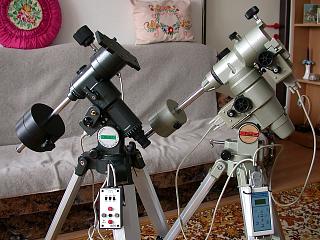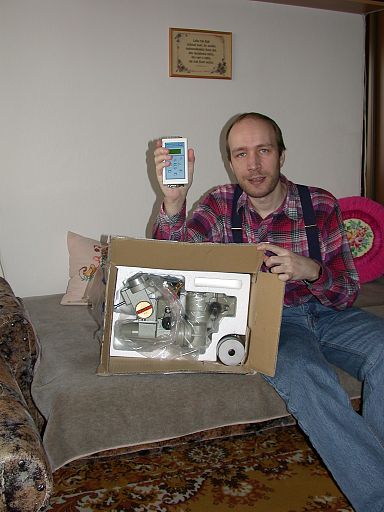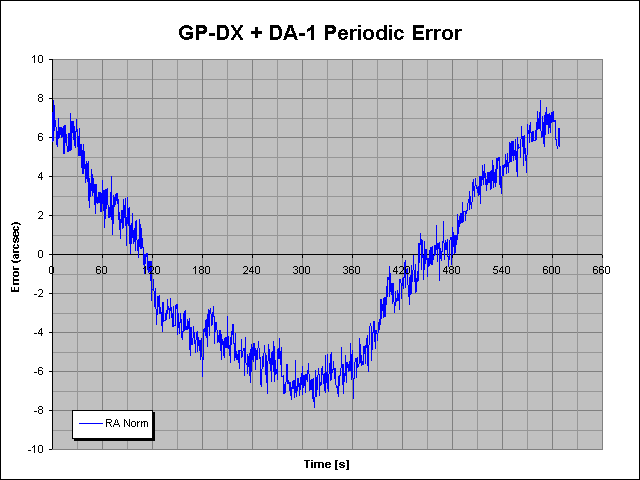| Vixen GP-DX
equipped with Astromeccanica's DA-1 drive system Vixen GP-DX (Great
Polaris - DeLuxe) equatorial mount is very well-known
mount in the world. It can hold accessories up to 10-11kg
and provides high tracking accuracy.
1, Making decision
about suitable mount type and motor drive system
2, The first
tests
3, DA-1
detailed review
1, Making decision about
suitable mount type and motor drive system

The rivals ;-) |
|
After a year of deepsky
astrophotography with my entry level GEM1 mount,
in September 2002 I started to contemplate about
a better mount.
Here are the reasons:
1, GEM1 mount has high periodic error
- up to +/- 40arcsec (80arcsec peak to peak).
You can do a lot of nice photographs also with
GEM1 (see my Messier
catalog - all photos till the start of
November 2002 were done with GEM1!), but there is
a problem with number of useful frames. When I
used 20second exposure in prime focus, I could
use only 25% of frames (frames without star
trails)
2, Modified
GEM1 mount with autoguiding
system was my substantial step forward
in deep-sky imaging, but the whole setup (8"
Newtonian + 80mm guide scope) was rather big for
my balcony, demanding on setup time and lot of
cables, necessity to aim guidescope, ...
Furthermore, the whole equipment was heavier than
8 kg - so it was at the boundary of possibilities
of GEM1.
3, As I am an employed man, I cannot
afford to spent a lot of time at night by
gathering useless frames, because the
next day I need to wake up to office ;-). |
Then I started to decide about mount type. I read many
articles about Synta's EQ6 mount, but I found it rather
big for my balcony and also read about problems with
periodic error (about the same range as my GEM1). The
most accessible mount for me in European market was just
GP-DX.
Just at the same time I started very friendly
communication with Paolo Lazzarotti from Astromeccanica
company. I knew Paolo from my previous contact with
Astromeccanica, when I searched for suitable adapter for
my Nikon Coolpix 995
digital camera - they offer the cheapest adapter for
Nikon in Europe!.
After some communication I came into agreement with
Astromeccanica company and we did a bussiness. I provided
them permission to distribute a special release of K3CCDTools
for Astromeccanica and they provided me GP-DX mount with
DA-1 kit.
It was very nice offer for me, because Astromeccanica
is manufacturing
DA-1 Dual Axis drive kit. It has reasonable price,
enables computer control, autoguiding. And it has a
display - I love displays ;-))). Very important feature
is, that it has belt system for driving - it reduces
vibrations from stepper motors (look here to learn more
about vibration problem - Carsten's
page about DA-1).
2,
The first tests
Finally, on December
the 5th 2002, my mount and DA-1 drive system
arrived :-)).
The small package, but more than 17kg!
Notice the nice DA-1 controller in my hand...Here
is a table with weights of components:
| GPDX+DA-1 motors |
7.6kg |
| Vixen counterweight |
3733g |
| Astromeccanica counterweight |
4077g |
| Shaft |
836g |
| DA-1 hand controller |
180g |
| Dovetail plate (from Orion Optics) |
650g |
Remark: The old plate for attaching my Orion
Optics scope to GEM1 mount has weight only 180g.
The new dovetail plate is 530g heavier.
Dovetail plate + cradles weight is 1491g.
|
 |
As soon as sky was clear, I went to balcony to do the
first tests - to check this exceptional mount with DA-1
drive system.
Here is my periodic error
measurement of GP-DX + DA-1 system:

Click the
graph to see detailed graph. |
The periodic error was measured
by K3CCDTools with
its Drift Explorer.
Star: Alnitak (z
Orionis - DEC=-1°56'26")
Scope: 8" Orion Optics Europa Newtonian + 2X
Barlow
Resolution: 0.48 arcsec/pixel
Seing conditions were rather poor, so curve is
rather jerky. Seeing error could be about +/-1arcsec.
But don't forget - it is high resolution graph -
with +/- 10" limits in Y axis.
I must say, I am amazed by operation of GP-DX and
its low periodic error - less than +/-8 arcsec!
With good seeing it would be even +/-7 arcsec.
But I will have to measure it again, when
conditions allows it. |
The page is still under construction. New informations
are continually filled up.
See DA-1
detailed review
See Equatorial
Mount Tracking Errors page
See Tests and
Analyses of Homemade GEM1 Guiding System
See Homemade
GEM1 Autoguiding Setup
Back to AstroPhotography page
Computer generated images,
real images, drawings and texts are property of the
author and may not be reproduced or used without
permission of author.

Last Update:
11.02.2003
|